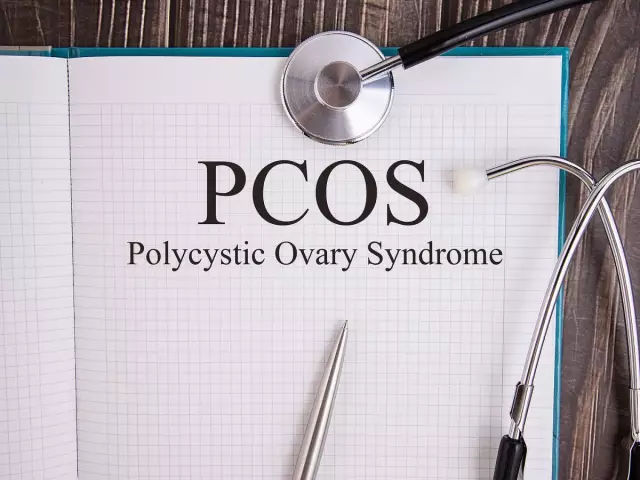- Author Rachel Wainwright [email protected].
- Public 2023-12-15 07:39.
- Last modified 2025-11-02 20:14.
Polycystic ovary

Polycystic ovary disease is a fairly common hormonal disorder in women that leads to infertility. This disorder is characterized by the absence or irregularity of ovulation at a particular phase of the cycle. This is due to the enlargement of the ovaries and the content in them of a large number of small non-developing follicles filled with fluid, which are called cysts. The hormonal imbalance, which is provoked by this disease, leads to various external and internal disorders of the female body.
Causes of polycystic ovary
The exact causes of polycystic ovary disease are still unknown, but it is clear that with this disease, the female body produces an excess amount of androgens (male hormones). This is due to the high level of insulin in the blood, to which the body reacts with excess production of androgens. This fact leads to a disruption in the balance of female and male hormones, which causes rare ovulation or its absence at all. Some of the most common causes of polycystic ovary disease include:
- Heredity;
- Nervous stress and emotional stress;
- Colds (in particular, angina);
- Climate change.
Most often, the causes of polycystic ovary are dysfunctions of the following organs:
- Ovaries;
- Thyroid gland;
- The hypothalamus;
- Pituitary gland;
- Adrenal glands.
Timely identification of the cause of polycystic ovary disease and its treatment helps to avoid various complications that are characteristic of this disease. It should be noted that these include some cardiovascular diseases as well as diabetes mellitus.
Symptoms of polycystic ovary
Clinically, polycystic ovary disease manifests itself in different ways, depending on the cause. However, there are specific signs of this disease, by which one can judge about its presence in a woman:
- Absence or irregular menstruation (sometimes delay up to 35 days);
- Increased hair growth, most often on the face, in the chest and abdomen, less often on the back, in the groin, on the arms and legs;
- Uterine bleeding;
- Pimples and acne;
- Thin hair or baldness;
- Obesity in the hips and waist and general weight gain;
- High blood pressure;
- Enlargement of the ovaries and the formation of cysts in them;
- Miscarriage or infertility.
In some cases, darkening of the skin on the back of the head, in the armpits, on the inner thighs, in the groin, and under the mammary glands can also act as a symptom of polycystic ovary disease. This phenomenon is called acanthokeratoderma in medicine.
In addition, some of the symptoms of polycystic ovary disease are similar to those of diabetes mellitus, such as increased urination, weight gain, chronic skin infections, and candidiasis or vaginal thrush.
At the same time, it can be argued that the most certain symptoms of polycystic ovary are menstrual irregularities or no menstruation at all, as well as ovarian enlargement, which is most often detected by ultrasound examination.
Usually, this disease develops during puberty or specifically with the onset of menstruation. The interval between periods, which is more than 35 days, or the number of menstruation less than 8 times a year already indicates the presence of serious disorders in the female body. If such deviations are observed, the likelihood of developing polycystic ovary increases.
Treatment of polycystic ovary
Today, polycystic ovary disease is treated in two ways: conservative and operative. The first method involves the use of various hormonal drugs that stimulate the growth and development of one or more mature follicles in the ovaries, thereby causing ovulation. The efficiency of the conservative method is about 50%.
The second method of treating polycystic ovary has been practiced since the beginning of the century and is a surgical intervention on the ovaries, which allows ovulation (efficiency is about 90%) and restoration of fertility (occurs in 70% of cases).
The conservative method is aimed at eliminating the clinical manifestations of the disease in a woman. In some cases, in the treatment of polycystic ovary, oral contraceptives are prescribed for 2-3 months, which have antiandrogenic properties. During this period, the work of the ovaries is normalized, and ovulation is restored. Thus, the question of whether it is possible to become pregnant with polycystic ovary may have a positive answer. This method is also used for women who are not planning a pregnancy, since it eliminates hormonal disorders in general.

If this method turns out to be ineffective, then a generally accepted technique is carried out, aimed at stimulating ovulation. This course lasts from 4 months to half a year. It involves the use of specific hormones in the first phase of the cycle, then an ovulation stimulator during the development of the follicle, and then various drugs designed to support its functions. Weight loss medications are often used in the treatment of polycystic ovary disease. In some cases, it is weight loss that helps restore ovulation.
The operative method of treating the disease is based on the destruction or removal of the part of the ovary that synthesizes androgens. It should be said that the effect of this method is rather short-term, since the ovary is quickly restored. Therefore, if a similar operation was performed, with polycystic ovaries, you can become pregnant within 4-5 months until recovery has occurred.
This method is carried out using a wedge resection or laparoscopic electrocoagulation of the ovaries. In the first case, a small part of the ovaries is removed from both sides, ovulation is restored in 85% of cases. The second method is considered more gentle, since it simply makes incisions on the ovaries in several places. This significantly reduces the risk of adhesions in the pelvis.
YouTube video related to the article:
The information is generalized and provided for informational purposes only. At the first sign of illness, see your doctor. Self-medication is hazardous to health!





